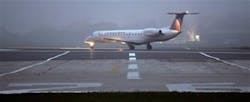They almost made it.
Despite lining up for takeoff on the wrong runway, Atlanta-bound Comair Flight 5191 accelerated to 137 nautical miles an hour Sunday and had begun to lift its nose wheel off the ground when it charged off the darkened end of the 3,500-foot strip, went into the grass, collided with a grass berm and briefly became airborne, officials said Monday night.
The plane plowed through a fence nearly 400 feet from the runway end, jumped another fence at about 700 feet, then struck a stand of 50-foot tall trees and broke apart. The crash and ensuing fire killed 49 of the 50 people aboard the Canadair Regional Jet. First officer James Polehinke, who was at the controls, remains in critical condition.
"The aircraft weighed 49,087 pounds according to its manifest," Debbie Hersman, an NTSB member overseeing the investigation, told reporters at a briefing. "It needed 3,539 feet of runway to rotate the nose wheel at that weight."
Hersman said air traffic control and cockpit voice recorder tapes show that Capt. Jeffrey Clay, a seven-year veteran at Comair, and Polehinke believed they were on Runway 22, the 7,000-foot runway built for airliners and corporate jets. In fact, in Sunday's pre-dawn darkness, they had mistakenly aligned their jet with the much shorter, unlighted Runway 26.
Hersman said they noted during the takeoff roll that the runway lights were out, but it wasn't known whether they ever realized they were on the wrong runway.
Polehinke, 44, was at the controls at the time of the accident, officials said Monday.
The cockpit voice recorder shows the takeoff roll lasted 29 seconds until the aircraft hit the ground and lost electrical power.
The engine thrust reversers were stowed, and the plane's spoilers weren't armed, indicating the crew made no attempt to stop the plane.
"The flight crew did not receive any comments [from air traffic controllers or other aircraft] during the takeoff roll," Hersman said.
NTSB investigators combed the wreckage for a second day Monday under off-and-on rain. They have determined the crew's preflight actions were normal and that the plane's two engines appear to have been working normally.
Investigators were trying to determine why two experienced pilots who had flown safely to the same airport the previous night could have mistakenly lined up with the shorter runway believing they were on the longer runway.
In addition to being different lengths, Runway 22 is lighted while Runway 26 was not, they have different markings, and their direction --- meant to correspond with compass headings --- are 40 degrees apart.
Recent construction work at Lexington's Blue Grass Airport had slightly realigned the taxiway leading to both runways. Instead of following the taxiway to the end, the pilots were supposed to turn onto the shorter runway momentarily before following another taxiway to the longer one. They apparently turned onto the shorter one and began their tragic departure.
Investigators planned to retrace the ill-fated jet's path to the runway early this morning.
"We're trying to simulate conditions as they were [Sunday] at 6 a.m.," Hersman said. "We'll try to see what the pilots saw."
The NTSB and Comair officials declined to give details of the pilot's schedule in the hours leading up to the accident, but the agency is investigating. Regional airline crews typically arrive here about 10 p.m., check into a hotel, then return to the airport about 4:30 a.m. the next morning for a flight that departs at 6:10 a.m.
Pilots have long criticized such "stand-up" overnights as fatiguing and potentially dangerous and have sought to strengthen rules requiring additional crew rest. FAA regulations require airline crews to get 16 hours off duty after eight hours continuous flying. But pilots can be required to remain on duty up to 16 hours at a time and operate multiple flights.
Terry McVenes, a safety advocate at the Air Line Pilots Association, said Monday that FAA regulations should be modified.
"They were written 50 years ago when airlines flew piston planes and the types of schedules we see now weren't even contemplated," he said.
Pilots at some airlines had negotiated more restrictive rules for crew rest, but those have been relaxed in recent years as airlines have lost money and struggled to increase pilot productivity.
"The competitive economic environment in the airlines has brought all kinds of labor concessions," McVenes said. "Pilots are flying right up to the legal limits, and we really need to look at this back-side-of-the-clock flying and understand effects on safety and pilots' long-term health."
There was only one air traffic controller in the tower at the time of the accident, and that person had to coordinate several departures, ground movements and make weather reports.
Air traffic controllers are responsible for ensuring pilots are given the correct clearances and read them back properly, but they don't watch each airplane to make sure the crews follow instructions. Each airline captain is ultimately responsible for that.
The NTSB's Hersman said the lights on Runway 26, the short runway, were inoperative, and it would have been impossible for the air traffic controller to turn them on from the tower.
Air operations were nearly normal Monday, with another Comair jet filling in for the plane that was lost.
Sherri Miller of Richmond, Ky., stopped briefly at the airport's chain link fence to attach a bouquet of yellow flowers in remembrance of the people who perished.
"I knew Judy Rains," she said of a Lexington dog groomer who died on the way to St. Louis where she was to be married. "She groomed my dogs and she was a friend. But these flowers aren't just for her. They're for everyone who left us."
Copyright 2005 LexisNexis, a division of Reed Elsevier Inc. All rights reserved.
Terms and Conditions | Privacy Policy
News stories provided by third parties are not edited by "Site Publication" staff. For suggestions and comments, please click the Contact link at the bottom of this page.






